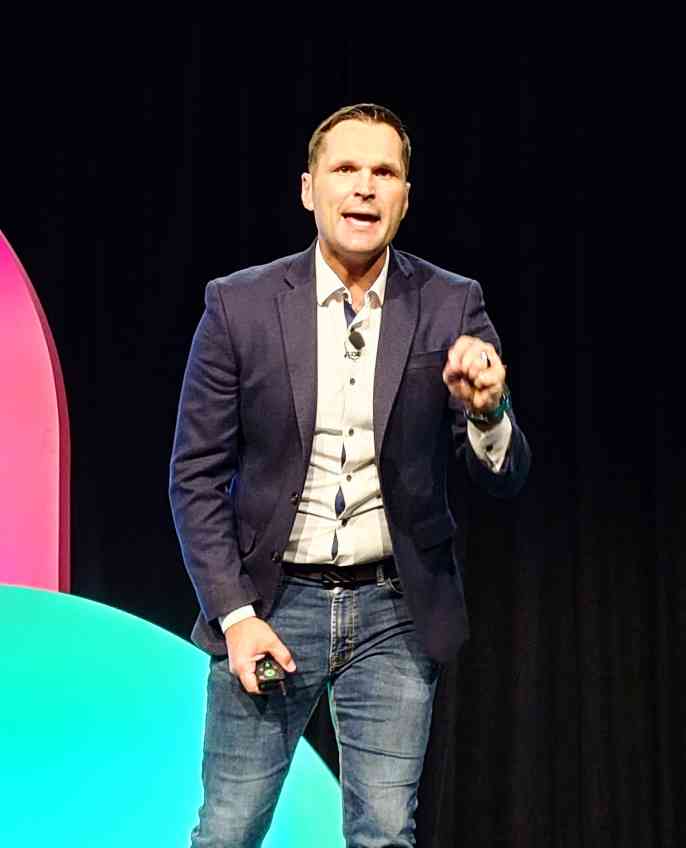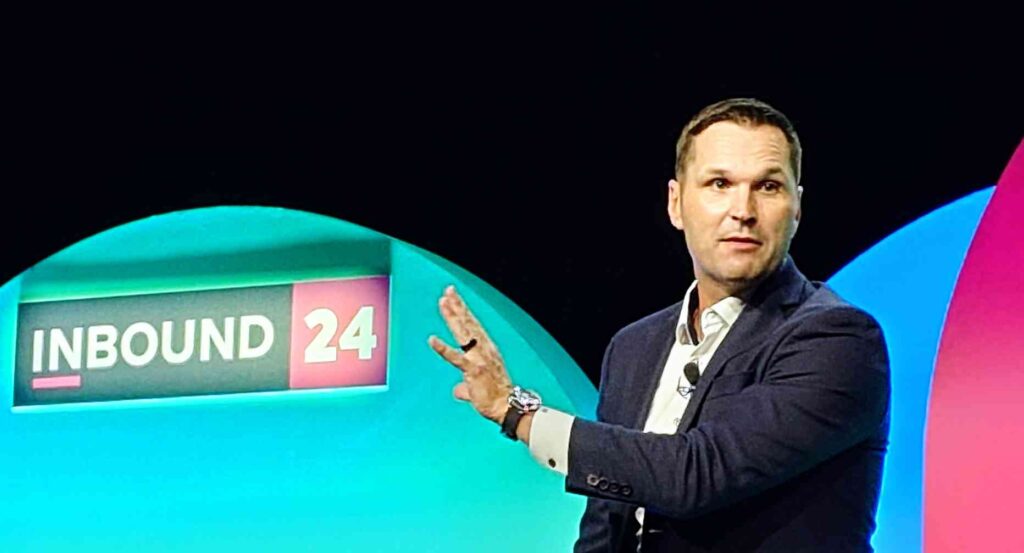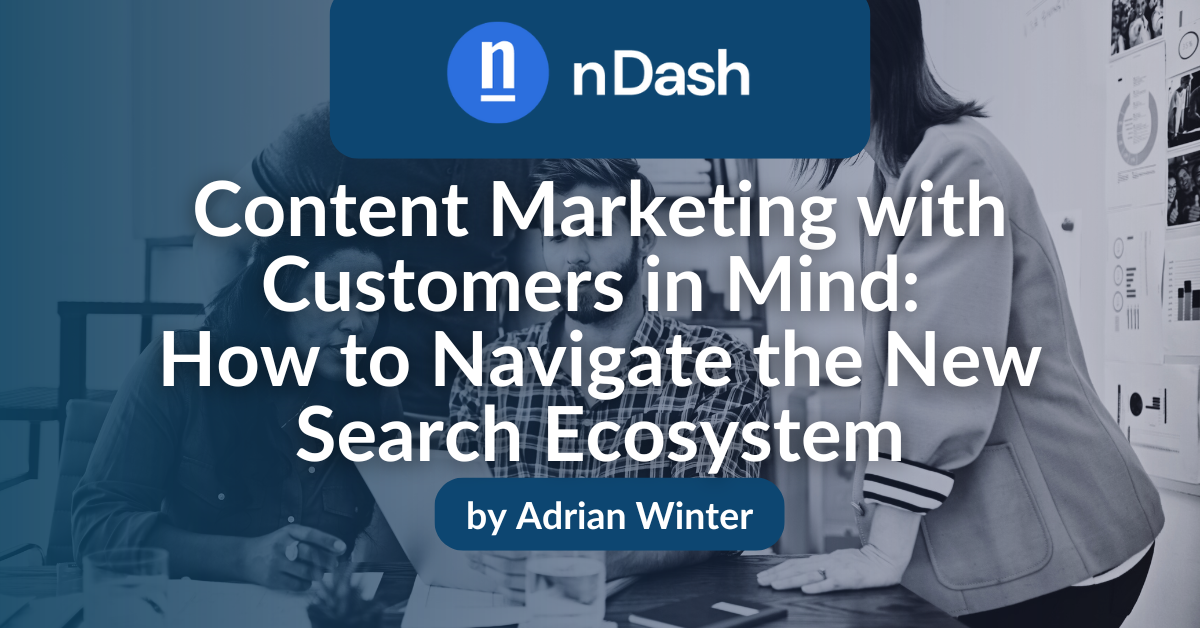Content marketing expert Marcus Sheridan captivated a massive audience at INBOUND 24. He promised a way to navigate the world of search beyond Google’s Helpful Content Update and AI.
Sheridan is the best-selling author of They Ask, You Answer and a business communications innovator. His presentation provided advice for content marketers in what he dubbed a ‘post-Google apocalypse’. Marketers must accept AI without letting it dominate their marketing strategy. Sheridan advised attendees to make sure the content they’re publishing answers the questions people are asking. He also touched on how to create effective short-form videos.
Marketing and Search in the Next Five Years
Sheridan emphasizes that it’s useless to try to predict marketing trends more than five years out. Technology advances at a rapid pace, so concentrate on the next few years instead. And what does that look like currently? Sheridan claims it boils down to two things:
- Websites still matter, though zero clicks will continue to affect search (and your website traffic)
- If it’s online, AI will access it. So make sure you’re signaling to AI that you’re the best possible source for the answers they generate.
Investing in your website does still matter despite the predicted 25% drop in search traffic. And that’s because it isn’t all about traffic. There are other reasons to create a repository of useful and up-to-date information, including:
- Thought leadership
- Sales team support
- Attracting talent
- Improved customer experiences
Additionally, it builds a robust content library that AI can (and will!) access. This helps signal AI to see you first and include your information in the answers it provides to users.

Content Marketing is All About Trust
The best way to dominate the conversation is to be a voice people trust. Do this by delivering valuable, well-researched information. This is where you lean into the ‘Big Five’ items that dominate the economy of search:
- Cost: Self-explanatory. Don’t obfuscate here.
- Problems (Fears): How do you solve their problem? Eliminate a fear they have. Make it obvious.
- Comparisons/Versus: Do their research for them and save them time and effort. Make it easy to say yes.
- Reviews: Everyone expects a brand to say it’s the best. It means something when your customers say you’re the best.
- Best: Don’t be afraid to recommend a competitor. Trying to make a sale when you’re not the best fit for a customer will only result in a bad customer journey.
These five questions cover pretty much everything someone would want to know on the buyer’s journey. Embrace a ‘seller-free’ ecosystem. Empower visitors to explore and find everything they need without having to call or fill out a contact form. Nothing turns off today’s customers more than being forced to approach you before they’re ready.
Market Like A Media Company
Your approach and priorities change when you start seeing everything as a media opportunity. Be a media company first and foremost, and the rest of the marketing will fall into place. This means investing in videographers and leaning into short-form video. As an example, Sheridan presents Sheffield Metals’ YouTube channel. They’ve called it The Metal Roofing Channel rather than Sheffield Metals. This positions them as the number one voice in metal roofing, with one person as the face of the channel.
Having a ‘main character’ like this makes your content more personable. It gives your audience someone they can place their trust in. Then, when they make a buying decision, they’ll go to the company behind their trusted favorite content creator. That’s the way to position yourself as an authority.
Sheridan’s presentation goes further, providing a five-step template for engaging, impactful short videos:
- The Hook: Within the first three seconds of the video, create a question or curiosity gap. You want your audience to wonder how the video ends.
- The 3-Second Rule: Change scenes every three seconds to keep the pacing tight. A bored viewer will leave and will not return.
- The Progress Principle: Every scene in the video needs to be building towards the payoff. Don’t include fluff or scenes that don’t make sense.
- The Payoff Principle: Don’t forget to deliver on the premise! Answer the question. Resolve the plot.
- The ‘Quit While You’re Ahead’ Principle: Don’t overstay your welcome. Stop right after the payoff. Hit viewers with the big reveal and then get out.
His strategy centers around respecting your audience. This principle underpinned the next section of his presentation, too.
Empower Your Customers With Content
Circling back to the topic of trust, content marketing must acknowledge that it’s a two-way street. Yes, you want your customers to trust you as an authority or just a pair of safe hands. But you should also trust your audience to control their own customer journey.
What does this look like? A website is full of self-service tools like AI graders, product comparison quizzes, and price estimators. Don’t force them to contact you. Or, as Sheridan put it, ’Call for quote’ is the middle finger of the internet.
As you build relationships with your audience, you can also go a step further. In other words, trust them to add to your content marketing. User-generated content is a fantastic way to build up organic social proof. And it’s easier than pestering your customers for reviews.
An additional feature Sheridan recommended for websites is ‘pillar pages’. A pillar page acts like a primer on all aspects of a topic. It answers the Big Five in a range of media formats with options for more in-depth subtopics. This empowers your customers with everything they need to make their purchasing decisions. It also builds a knowledge base that is easy for AI and humans alike to access.

Key Takeaways for Content Marketing Managers
One thing Sheridan didn’t mention that we like to respect is that marketing professionals don’t have time to waste. So, we’re summarizing the four main ideas of his informative talk:
Don’t follow. Lead.
Be the expert on your industry. Be the local option (Google My Business is still relevant!). Build a community of loyal fans who want to promote your content and your brand to their own networks. In other words, do your research to create engaging content that doesn’t waste people’s time and delivers on a promise.
Dare to be different.
You don’t need to reinvent the wheel or be the best (though that helps!). It’s enough to be different. After all, it’s just water until it’s branded as Liquid Death and given a winning aesthetic. Figure out your Liquid Death angle and stand out from the competition.
Think like a media company.
Invest in a full-time videographer. Buy the camera, ring light, audio software, or whatever you need to take media production seriously. Brands that treat marketing as something that a receptionist can do won’t see results. A brand that values its content marketers empowers them to make impactful audio and video. And that’s what produces results.
Show and tell what others won’t.
Don’t try to gatekeep information to bait people into making contact. Give them what they’re looking for upfront, with no strings attached. They’ll come back again and again because you’re now a reference tool for them. This means having everything they need to make a buying decision on your website. Don’t make them email or call you before they’re ready. This also saves you valuable time!
Was the Content Marketing Roadmap Worthwhile?
If you had limited time to spend at INBOUND 24, this would be one of the most valuable sessions. Sheridan followed his own principles. His talk delivered immediate value rather than hitting hard on the sales pitch.
He thinks like a customer. When building his customer journey, he considers what’s best for the customer rather than the business. The secret: what’s best for the customer (even if it’s a competitor) is what’s best for the business. This results in a relationship that’s more like a collaboration than, say, a fisherman and their quarry.
About the Author
 Adrian Winter is a seasoned writer and marketer with a decade of experience in transforming events into profit centers and crafting impactful content across print and digital platforms. He specializes in growing audiences and delivering dynamic, results-driven materials.
Adrian Winter is a seasoned writer and marketer with a decade of experience in transforming events into profit centers and crafting impactful content across print and digital platforms. He specializes in growing audiences and delivering dynamic, results-driven materials.
Check out Adrian’s nDash writing profile here: Adrian Winter.
